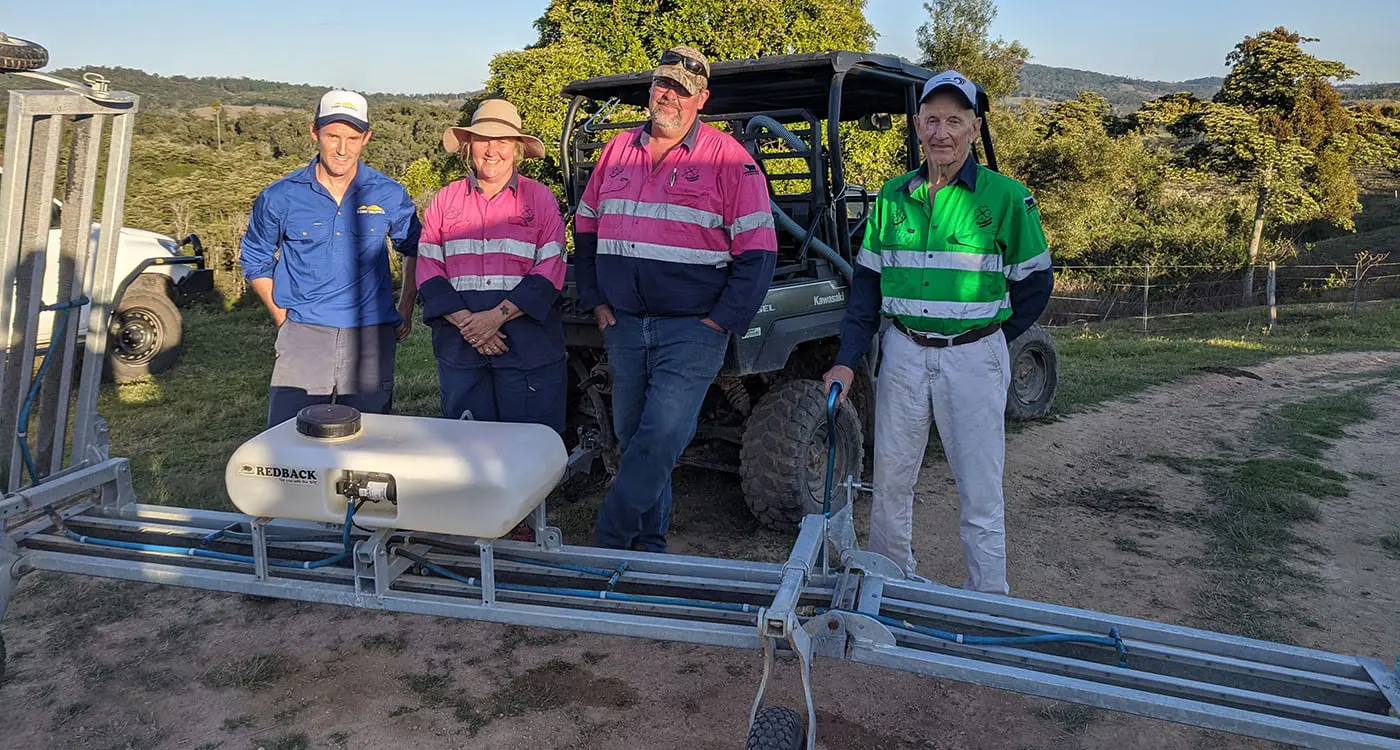
Jim Fletcher, DAF, addresses landholders attending the GRT workshop at Cloudbreak Farm, Eungella.
Watch this video
Our mates at SQ Landscapes recently produced this video about giant rats tail grass.
We think it’s a great explainer showing what to look out for and why it’s important to eradicate the weed early to avoid long-term infestations.
Check it out here.
Catchment-wide approach to GRT

Jim Fletcher, DAF, explaining the typical habitat for GRT.
Landholders of the Upper Broken River catchment are taking a catchment-wide approach to manage giant rat’s tail (GRT) grass.
A workshop attended was held at Cloudbreak Farm, Eungella last month to discuss the effectiveness of different management strategies that are being implemented.
There were 23 landholders from the Upper Broken River catchment (Eungella, Broken River, Crediton and Dalrymple Heights areas) at the GRT management field walk in September.
GRT grass poses a major threat to landholders and producers in the Upper Broken River catchment. It’s an invasive grass that spreads quickly, out-competes desirable pastures, and causes significant degradation that can result in reducing stocking rates.
Landholders rely on a combination of chemical and mechanical controls coupled with changes in land management practices to reduce its impact with no single option on its own being totally effective.
Charters Towers Tropical Weed Research Centre researcher Dr Wayne Vogler and Department of Agriculture and Fisheries’ Jim Fletcher were guest speakers at the event.
Dr Vogler spoke about the various management methods deployed against GRT and fielded a number of landholder questions about best-practice control methods.
He said there was no single answer to controlling GRT, and landholders who used only herbicides would lose the battle.
“Maintaining pasture cover and condition is critical for effective GRT management,” he said.
Mr Fletcher led a field walk, and explained the difference between GRT and Giant Parramatta Grass, also a category 3 invasive plant, but less of a problem than GRT.
He said it was sometimes better to invest money to make pastures more competitive, rather than buying bottle of chemical.
Landholders Kel and Mandy Tennent are trialling a weed wiper to manage GRT grass and other weeds. The Tennents have undertaken weeds and chemical control training.
Outcomes expected include reduced herbicide use and overspray, and improved land and water condition on the property.
“Apart from initial teething issues, we are really happy with the weed wiper. The immediate bonus has been that we can still use it on windy days, and there’s been a huge decrease in the amount of chemical usage, therefore reducing costs.”
Kel Tennent, Cloudbreak, Eungella
LDC’s Land Management Support Coordinator Rodger Walker (left) with hosts at the Cloudbreak Farm field day (from left) Mandy, Kell and Cliff Tennent beside their weed wiper.
Knocking down barriers to change
Exploring New Incentives looks at ways to address financial and other barriers to the adoption of improved grazing land management practices and landscape remediation approaches in the BBB catchment.
A New Incentives grants framework was developed to help grazing enterprises to build resilience into their business while improving water quality outcomes, production, and the knowledge and skills of people working in the enterprise.
The grants were aimed at encouraging graziers with innovative ideas they wanted to trial aimed at tackling property issues such as weeds, animal health and welfare, herd productivity, and erosion. Providing their proposals met strict criteria, the LDC team linked graziers to the right expertise and resources to help them implement the project.
Approved projects included: spray mister, weed wiper, water telemetry, pregnancy testing units and a Demonstration Site and Learning Hub.
Larry Lush (left) listens intently to host landholder Kell Tennent (pink shirt) giving a rundown of the operation of Cloudbreak Farm’s weed wiper.
Wayne Vogler DAF explaining the intracacies of GRT mgmt inside the refurbished old dairy shed.




